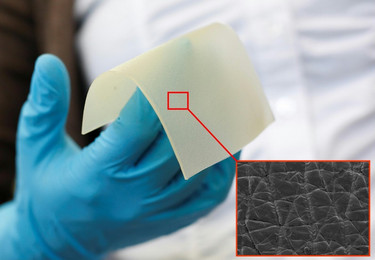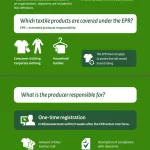Scientists from the Neuromarketing Labs and the Hohenstein Institute are currently working on a pilot study for the perception of textiles worn close to the body. An experimental test records the effect of clothing on the emotions and thinking processes in the human brain. Scientists observe the brains of test persons while wearing tight clothing – significant differences appear in terms of alertness – In a pilot study on the neurophysiological perception of textiles on the skin, scientists at the Hohenstein Institute and at Neuromarketing Labs investigated thinking processes while test persons wear business underwear: Test winner was “99°F”.
Scientists from two different fields – textile research and neurosciences – are working together to understand how we perceive, feel or evaluate clothing on our skin. The researchers use special measuring devices in the laboratory to record the friction parameters (tribology) of textiles on human skin. This is followed by measurement series using high resolution EEG examinations on test subjects to provide exciting insights into our brain and the feelings generated during the wearing of textiles.

Neurophysiological study with test subjects, performed using the SOFIA textile applicator and an EEG. The SOFIA textile applicator for the first time ever allows textiles to be moved along different parts of the human body with adjustable pressure and adaptable speed. The EEG records the brain’s reaction to the textile stimulus immediately. ©Hohenstein Institute – Department of Hygiene, Environment & Medicine
Prof. Dr. Dirk Höfer, director of the Department of Hygiene, Environment & Medicine at the Hohenstein Institute and Dr. Kai-Markus Müller, managing director of The Neuromarketing Labs, are currently conducting this worldwide unique pilot study for the perception of textiles worn close to the body.
The scientists agree : Previous neurophysiological research on the processing of sensations (perception) was strongly focused on acoustic and visual influences on the human capacity for performance and concentration. But what about the material that touches the largest human organ – the skin – for 24 hours every day without interruption? How does clothing influence our intellectual capacity and what exactly do the wearers feel? Can wellness textiles or business textiles actually trigger relaxation or even actively influence a person’s physical regeneration?

Part of a 64-channel EEG spectrum for objective and controlled recording of the reaction of the human brain, e.g. to contact with textiles. ©The Neuromarketing Labs
These and other questions are now being examined in the framework of the cooperation between The Neuromarketing Labs and the Hohenstein Institute under the aspect of neuroscience for the first time. The research project already combined friction tests (friction measurements of textiles on the skin) with neurophysiological methods to analyse the test subjects’ acceptance of the textiles. A 64-channel EEG (electroencephalography) is used as a new method to provide insights into the activity of the human brain and its world of emotions down to a millisecond. Based on decades of basic research, the EEG can measure level of attention as well as positive and negative emotions.
Compared to context-related evaluation using questionnaires, the advantage of this method is the direct and therefore instinctive evaluation of arising emotions. Under the scientific direction of Dr. Kai-Markus Müller and Davide Baldo, The Neuromarketing Labs modified the basic scientific analysis methods and approaches to allow economical and practical application.
The tribological systems for testing friction on the skin allow textile manufacturers to characterise important properties such as static or dynamic friction coefficients in comparison to standardised, biometric human skin (HUMskin). This skin model possesses the typical surface structure and elastic properties of human skin.
For the EEG examinations regarding the perception of clothing, the team from the Department of Hygiene, Environment & Medicine of Prof. Dr. Dirk Höfer specifically developed a special textile skin applicator which they christened SOFIA (SOFIA, acronym: Standardised Operating FabrIc Applicator, see figure 3). SOFIA is an ideal supplement to the tribological measuring methods and for the first time ever allows textiles to be moved along different parts of the human body with adjustable pressure and adaptable speed, i.e. the parameters crucial to perception. Using SOFIA in combination with the EEG electroencephalo-graphy now provides the researchers in the SOFIA study with objective and controlled recordings of how the human brain reacts when the fabric touches different parts of the body.
Ideally, textiles should not be consciously perceived while they are worn, so that we are left unaffected by our clothing. However, clothing design, the quality of materials and the seams of textiles can demand more attention from the brain than one would like during a working day. People who have to wear corporate identity (CI) clothing can tell a thing or two about constantly rubbing or scratching labels or seams and blouses that are too tight. The SOFIA study, which took an EEG brain scan of 24 test subjects while they were wearing business underwear, has now demonstrated the significant impact of tight textiles on our capacity to think.

Friction measured on artificial skin (technical Skin Model/HUMskin) The measurements make it possible to determine the frictional resistance of textiles directly and in a uniform way on human skin. The 99°F business undershirt had the lowest frictional resistance (friction value) in this experiment.
This unique study worldwide compared three different materials: linen as control, a premium double rib product made of cotton, and a newly developed business undershirt made by 99°F. All the test materials were initially put through a friction test, as the friction of textiles on human skin can provide important information about the perception of textiles. The friction test showed significant differences between 99°F and the premium double rib product. Without being able to see the different textiles (blind study), the materials were moved on the hand and underarm of test persons using the special textile applicator SOFIA. Contact pressure and application speed were choosen in accordance to how underwear typically moves on the skin. The scientists simultaneously recorded the electrical activity of the brain using a 64 channel EEG. Different sounds were played in parallel to the measurements. The brain’s reaction to these sounds allowed the determination of how the tight contact with the material distracts the participants in the study.
The results were more than surprising: The EEG brain scans showed that all test subjects had far lower mental reserves when linen or the double rib product was applied. Applying the 99°F business undershirt, in contrast, the brain’s response was significantly stronger. The 99°F business undershirt distracted the test person less than the cotton premium brand and left more room in the brain for other thinking processes and alertness. Measurements were neutral, that means that the test samples were not seen by the test persons. Immediately, the brain’s uninfluenceable response to the textile and acoustic stimuli was measured after a few hundred milliseconds. The scientists used a brain response that has been investigated in a number of well-substantiated studies so that they could avoid questionnaires which otherwise are typical of such studies with test persons. Therefore they were able to generate strictly objective data. The results of the study are currently being prepared for a scientific publication in an international renowned journal.

Preliminary results of the SOFIA study demonstrate significant differences between the tested textiles. The 99°F business undershirt was scarcely perceived by all test subjects as a stimulus on the skin, so that the test subjects had greater mental capacity to process other tasks.
What might be the impact of the SOFIA study on the textile world, regardless of its academic significance? Firstly, the results are relevant when it comes to the development or optimization of specific clothing so that it does not unnecessarily distract the wearer, but actively supports whatever the wearer is doing (e.g. CI wear, military clothing, clothing for pilots or air traffic controllers and so on). Secondly, the researchers working with Prof. Dr. Dirk Höfer (Hohenstein Institute) and Dr. Kai-Markus Müller (Neuromarketing Labs) are able to measure the potential impact of textiles on concentration directly on the brain and therefore to make reliable statements about the acceptance of textiles.
Dr. Kai-Markus Müller is the managing director and founder of The Neuromarketing Labs. He worked in basic brain research for over 10 years and has had several years of experience in private enterprises, including as a management consultant at Simon-Kucher & Partners. He founded The Neuromarketing Labs in 2011 to provide the industry with state-of-the-art neuroscience findings and research methods.
Prof. Dr. Dirk Höfer is director of the Dept. of Hygiene, Environment & Medicine and Dy. Director of the Hohenstein Institut für Textilinnovation gGmbH (HIT). His interest is focused on textile-related influences on health. He has developed numerous medical textiles with protective and therapeutic functions and refined methods and models for examining the effect of materials in contact with humans or microorganisms. As a specialist physician for anatomy he is interested in the perception of textiles on human skin from a neurophysiological point of view.






